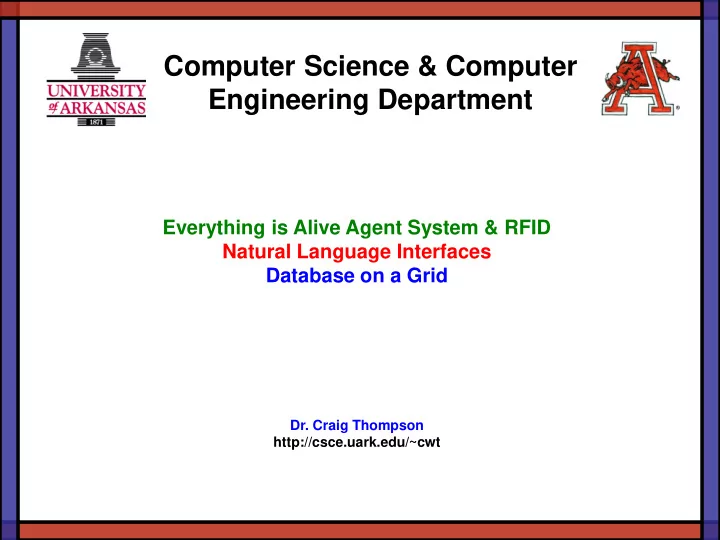

Computer Science & Computer Engineering Department Everything is Alive Agent System & RFID Natural Language Interfaces Database on a Grid Dr. Craig Thompson http://csce.uark.edu/~cwt
Context: Knowledge Cycle problems … University NSF, DARPA, … Wal-Mart solutions Research Acxiom Funded projects Class projects Students Special projects Students learn the learn the latest ideas basics and how to solve problems Teaching new hires, interns, coops, supported students
Everything is Alive Agent System & RFID Enterprise Integration Architecture
Everything is Alive orders & observations & subscriptions recommendations Need Any I see a fuel! threats? tank!
An RFID Tag
RFID Reader
R = RFID Reader Pallet/Container/Item R R R R Loading R dock Camera R R R R Conveyor belt R R Pallets Storage R R R R Distribution Center
… Reader 1 Reader 2 Conveyor Belt Tag Printer Camera Device agent Wrappers wrappers XML XML Commands Data XML/WSDL messages sent between “agents” … DBMS GUI Dashboard • Uses a Service Oriented Architecture • Compatible with WSDL
Natural Language Interfaces
Basic MBNLI S User interface NP VP Including menus and answers Light – turn on Grammar & Predictive Parser Lexicon Including translations Other info e.g. DBMS schema Target System e.g. a DBMS or resource
DBMS on a Grid
Query Layer Workflow Layer Query Tree consists of relational algebra automated translated to operators like join, project, select but also stored procedure calls Workflow i scheduled optimized Query i Workflow Query Execution Execution results in results data sources in tables Indexing Layer Indexing Layer TREE k HASH j … … HASH i TREE j … … … … … … Grid-node-based Storage Layer Disk-based Storage Layer … … Relational DBMS Architecture Data Grid Architecture
BACKUP
What is a Grid? • A grid or cluster is a collection of computers that work together to solve a problem • Types of grids – Computational grids – reducing execution time – Data grids – large scale data management problems Why Use a Grid? • Commodity processors - Custom supercomputer are expensive • Scalable - Cheap storage and large datasets • Take advantage of parallelism DBMS on a Grid • In certain high-end data-centric applications, practitioners are discovering that traditional relational database technology is not meeting their requirements for huge data sets, high transaction throughput, cheap storage, and flexible workflow support – so they are switching to grid technology. Can we have our cake and eat it too? Do we have to give up relational capabilities to get grid benefits?
Web-enabled MBNLI Web Page Web Page User interface User interface Grammar & MBNLI I/F Lexicon descriptor Parser Farm(s) Target System(s) e.g. a DBMS or resource
Recommend
More recommend